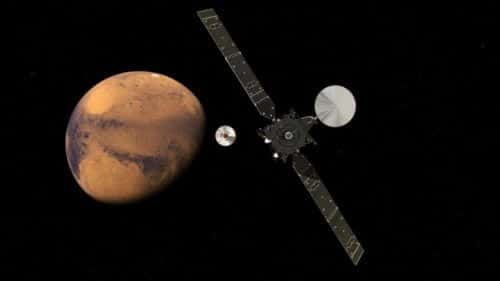The spacecraft that weighs 577 kg successfully separated from its mother ship - Exo Mars on Sunday afternoon and is now on a direct course to meet the atmosphere of Mars. When it arrives it will have just under six minutes to reduce its speed from 21 km/h to zero to make a bouncy but soft landing on the dusty Martian soil

The European Space Agency's Shipriley spacecraft is on track to land on Mars tomorrow, October 19.
Updates
- Fear of losing the lander: Skiparelli's parachute broke off earlier than expected
- Lost contact with Shipriley landing on Mars; The Exo Mars rover has safely entered its orbit
The spacecraft that weighs 577 kg successfully separated from its mother ship - Exo Mars on Sunday afternoon and is now on a direct course to meet the atmosphere of Mars. When it arrives it will have just under six minutes to reduce its speed from 21 km/h to zero to make a bouncy but soft landing on the dusty Martian soil.
Meridian Crater, on the equator of Mars where you will land is also the place explored by the Opportunity rover and for the first time a double landing is made at the same place on Mars.
Shipriali is a technological demonstration system. Its purpose is to show the ability of the European Space Agency (ESA) to land on the neighboring planet. The agency tried this once before in an effort to land the robotic Beagle 2 spacecraft in 2003. The spacecraft managed to touch down, but failed to deploy its solar collectors properly, blocking all communications with Earth.
From this point of view Shifriali will not have a problem because it has no solar collectors, on the other hand the lander will only be able to work for about a week, until the energy in its batteries runs out.
The spacecraft that carried it, the ExoMars Trace Gas Orbiter, which will track the gases in the atmosphere, will be used as a relay for the radio transmissions for a distance of over 170 million km that now separate Earth and Mars.
Shipreali is now alone, and no one can change her course or give her new orders. The landing sequence on Wednesday is fully automatic. The spacecraft will be able to shed most of its speed thanks to heat shields that will push it against the steaming air and help it withstand temperatures of 1,500 degrees Celsius. The combination of a large parachute and a cluster of rocket engines will allow it to reach almost zero speed just above the surface. She will do the last two meters by falling on her stomach.
The spacecraft is supposed to transmit UHF transmissions that will herald the entry into the atmosphere, the descent and the animal phase, when an Indian radio telescope will be able to receive these transmissions and transmit them to the control center of the European Space Agency in Darmstadt. If the facility in India can still hear Shifriali at 15:00 GMT (18:00 Israel time) on Wednesday, it means that the spacecraft has landed safely on the ground.
And in the meantime, the mother spacecraft, which has a much longer mission ahead of it, will be maneuvered to reach a parking orbit around Mars and not crash into the planet or collide with Shipriley. On Wednesday, the Exo Mars spacecraft will undergo an engine burn that will place it in a large elliptical orbit around Mars.
In the coming years, the Mekpet will investigate the behavior of atmospheric components such as methane, water vapor and nitrogen dioxide. Although these gases are found in low concentrations in the atmosphere, they (especially methane) contain clues about the current state of activity on the planet, and they may even hint at the existence of life on Mars. Exo Mars was launched in March 2016 from Baikonur in Kazakhstan and is considered a joint European-Russian mission.
Live broadcast of Wednesday's landing on the European Space Agency website

2 תגובות
I didn't understand why the 577 kg spaceship couldn't be attached to light solar panels that deploy automatically, in addition to the electric motor already built into it. In this way, her mission on the surface of Mars could last months or even years instead of just a week - this is even if part of the array of solar panels is destroyed and/or not deployed properly, and even when the sandstorms cover the solar panels during the time.
And another question: Did and why did NASA give up on a moving probe on the surface of Mars?